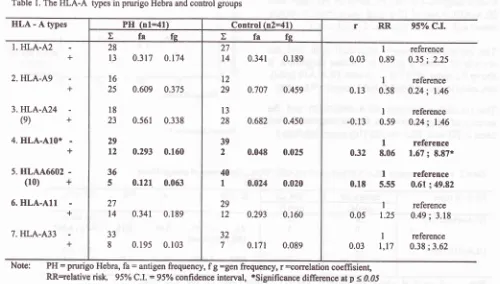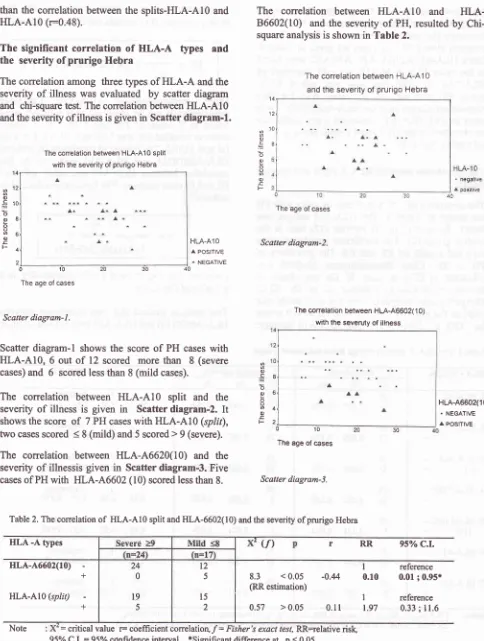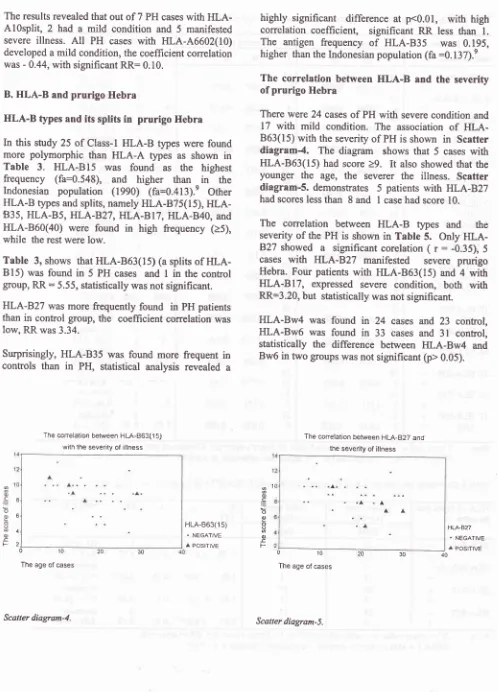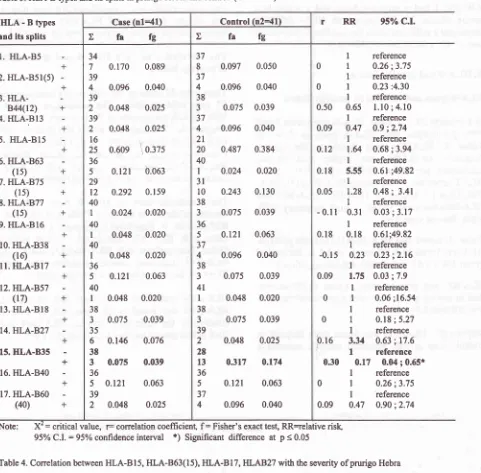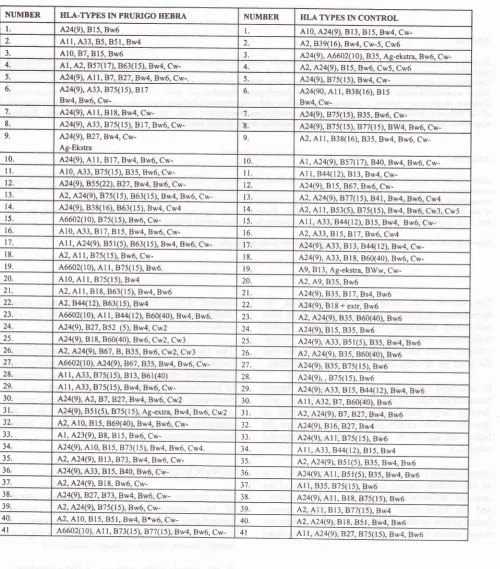Vol 9, No 4, October
-
December 2000 The rôle of HLtl antigens in prurigoHebra
223The Role of HlA-antigens
in Prurigo
Hebra
Siti Aisah Boediarda,'Moeslichan
S,# SantosoComain,/
UnandarBudimulja,# Adhi
Djuanda#Abstrak
Human leucoqtle antigens (HI'A) kelas
I
baik group A maupun B telah diketahui mempunyai hubungan dengan beberapa penyakit kulit, di antaranya psoriasis, dermatitis herpetiformis Duhring, dan lupus erttumatosus. Pada penelitian terdahulupruigo
Hebra (PH) telah diketahui diturunlean secara genetik mengikuti pola penuntnan multifaktor. Selain itu penderttupH
-sangat sensitif terhadap gigitan nyamuk, sehingga diduga terjadinya penyakit berkaitan denganfaldor
imunogenetik, yaitu HLA. Makalah ini mengemukakan hasil penelitian kasus-kontrol mengenai hubunganHLtl
kelasI
dengan PH yang dilakukandi
Subbagian llmu penyakitKulit dan
Kelamin, FKUI-RSCM Jakarta. Subyek penelitian mencakup4l
PH
dan
4l orang
sehat sebagii kontrol. Pemerilrsaan antigen HLA dilalatlran berdasarkan teknik milrolimfositotolcsik menggunalwnpiring
Terasahi yang dilengkapi antigenHI-'I
kelasI
untuk orang Asia buatanpabrik
One Lambda, USA 1997. Berdasarkanfrehtensi
antigen(a)
ditemukan HI-A-A| (fa=0.646) dan HLA-BI5 (a-548) merupakan tipe HLA yang terbanyak ditemukan, sesuai dengan tipe HLA orang Indonesia.HIÀ-Al0
ditemukan lebih banyak pada PH, dan dianggap sebagaifaHor
isiko
bermakna padaPH, isiko relatif
(RR):
8, inlerval kepercayaan(IK) 95%pada
1.67;38.87, denganfraksi etiologinya sebesar 25,60%. HI-4-A6602(10) dan HLA-827 kedua-duanya ditemulan sebagaifahor
risiko bermalçta untuk terjadinya PH yang ringan, RR:0,10 dengan K.I.gs% pada 0.01-0.95. Sedanglan HLA-863(15), walaupun tidak bermakna cenderung bermanifestasi sebagai PH berat denganÀÀ:
5.55. Pada penelitian ini nnpa diduga ditemukan HLtl-835 dengan RR:0,17, 1.K.95% pada 0.04;0.65, sebagai faWorprotehif
terhadap terjadinya PH. penemian beberapa antigen HLA pada PH memperhrat hasil penemuan pola penurunan genetik multifahor.Abstiact
Class-I human leucocyte antigens
(HI'tl)
group A and B have been investigated and associatedwith
various skin diseases, such as psoriasis, herpetdormis dermatitis of Duhring, and lupus erylhematosus.In
earlier study, the genetic inheritance of prurtgo Hebra (PH) has been analyzed andit
followed
the pattern of multifacbrtal tait. All of PH paiients hàd hypersensitiviry rèaitionito
insecl bite. TheseJindings assumed thatHLA
antigens might have an association with PH. Theprrpor"
ojihis stuay is to investigateClass-I
HLA antigens in PH patients. An unmatched case-control study was performedin
it
pattenti withpH
and4I
normal healtly perlon! (control group). The classI-HLtl
was investigated based on microlymphocytotoxicity method using Terasaki plate completed with Class-l HLA antigensfor
Asian (One Lambda, USA 1997). From the antigen frequLncy (fa) ofnU
investigation, nL,a-,AC (fa:0-646) and HLA-B|5 (fa:0.548) types, werefound morefrequent among the pipulafion snayfi=à4,
and it was consistent with lhe charactertsfics of class I -HI'A types of the Indonesian population.In
this snaynnl-l
t O wai jound itgnificantly more frequeny in PH patients than in the control group (RR-8.0 with 95% CJ. 1.67: S.S7).HLA-A||
was concluied asa-*îyactir
for
pH,îi* *,
etiologic fraction 25'60%. HIÀ-A6602(10) and HLA-827 were significantly found asiskfactors
that influeiced thL developmentof
nild
PH (RR:0.10 with 95%CJ O.il;
0.95). Individuals with HLA-863(15) clinically rcnà to develop seierepH
(RR:5.55, althoughnot signiJicant). Interestingly, HLA-835 was found more frequent
in the control group
tian in
pH
patieàts CJ. 0-04;0.65). HL4-835 was concluded to be asimificanl
tectivefactorlor
the dàetopment ofpH.
fny
ttudyllgueq
thatHIÀ
antigens are associated with PHa
the disèase. ihe polymorpii"g*ri
(mutrigenes)of
HLAfound in this study supported the theory thatPH
uern is compatiblewith
the mittijaaorialpittern.'
-Keywords: HLaL prurtgo Hebra,
HLtl-AI|,
riskfactor, HL4-B35, protectivefactor.Prurigo Hebra (PH) is
achronic skin
diseaseoccuring
mostly in children and young adults.
It
affects the
' Deparlment of Dermalo-venereologt, Faculty of Medicine,
University
a, Indonesia.t Cytologt
L
transplantation, Facultyof
T
Pathologt/Research Center
for
Medical Science and Technologt, Faculty of Medicine, University of Indonesia, Jalurta, Indonesia.face, extensors of the lower and upper extremities,
sometimes-
extending
to
the
buttocks
and the
abdomen.r-)No
systemic organ is involved. Consideringthe
frequent occurence
in
some families,
thehypersensitivity
to
insect
bite, bad hygiene
andpoor
224
BoediardjaetalIn
earlier
study,
the genetic inheritance
of
50
casesof
PH with family
tracing
in
three
generations suggestedthat the genetic inheritance
of
PH
followed
the multifactorial
pattern. There was
no
correlations
between
the severity
of
the disease
and
duration
of
illness.
The possibility
of
mutation was
excluded
in
statistical
analysis.ôThis
study
showed
that
somefamily
members
were affected and
had
hyper-sensitivity
to some allergens,
especially
insectbite'
It
was
assumedthat the immunogenetic factors, namely
HLA,
may be associated
with
or play a role
in
thedevelopment
of
PH.Many
experties
indicated the
association
of
classI-HLA
and class-Il
HLA with a
certain
degree
of
relative
risks (RR)
of
skin
diseases e-r2Ïhe
results
of
these evidences
varied, i.e.
HLA-A8 is correlated
with
Duhring
(RR:4.3), HLA-827 and
HLA-BI7
areassociat=ed
with
psoriasis, RR4 and 8, respectively.lO'lrHLA-DR3
is
correlated
with
cutaneous
lupuserythematosus
(RR:4.3).r0'rr
The
purpose
of
this
study
isto
investigate the association betweenClass-l
HLA
andprurigo
Hebra.MATERIALS
AND METHODS
An
unmatched case-control
study design
with
ratio
l:l
was
applied
in
this
assessment.
The study
population consistedof males and females
(unpregnant)age
5-30
years,
investigated
during May
1997 untilJuly
1998,
in
outpatients clinic
Departrnent
of
Dermato-Venereology
Dr.
Cipto
Mangunkusumo
CentralHospital (RSCM),
Jakarta.The patients were defined
asPH patients
with active
skin
manifestation
without
other
diseaseor
systemicorgan
involvement.
They
hadto be free
from
topical
and systemiccorticosteroid administration
two
weeksprior to
the study. The
severity
score
of PH
wasdefined as
the total
score
of
lesion distribution
plus
density
of
lesions. The involved
areas
such as the
lower and upper
extremities,
face,
buttocks
andabdomen,
eachpart
was
scored=
l.
The density
of
lesions score
was defined
as:
'l
meaning
rure,
2
:
scanty,3
=full.
The
clinical
severity was classified
asmild
if the
total score
was
8or
less and severeif
thetotal score
was 9 or more.
Control
group weredefined
asnormal healthy
personswho came
to
the hospital for paternity
test
or donor
test
for
kidney
or bone manow
transplantation or
persons
who worked
in
the hospital,
with
age
5-30Med J Indones
years.
This
studyrecruited
4l
cases and4l conliols
(o
:0.05,
statistical power
80%,RR=7)
Class I-HLA, namely
HLA-A
and HLA-B,
wereinvestigated using
HlA-class I
Asian dry tray loJ
#
1l
(antigen)made by
OneLambda,
USA
t997,"
the
reaction was
based
on the microlymphocytotoxicity
reaction.e'la-tuChi-square
test
or
Fisher's exact test
was performed
to
compare
the
antigen frequency
of
HLA-A
and
HLA-B antigens
of
case
and
control
gro,rps.tt Statistical analysis
was
calôulated
using
SPSS
program
for
rWindows release 6.0.RESTTLTS
Forty
onePH patients
and 4lnormal healthy
penionswere eligible
in
this
study. Prurigo Hebra
group consistedof
18 childrenof
5 - 18
years
old
and 23adults
of
19-30 years
of
age.
The
control
groupconsisted
of
3
children
of
5-18 years
old
and
38 adultsof
19-30 yearsofage.
The
mean age (years)of
the
PH
group
was 18
t
7,
while in
the
control
gtoup
22 + 4
years.
Statistically
age
distribution
in
thesetwo
groups was comparable.
The
sex
distribution of
4l
PH
patients
(8
males and
33
females)
and the
control
group
(17
males
and 24 females) was
significantly differenece (p<0.05, RR=2
with
95%C.l.:0.127;0.922).
The duration
of ilness varied
ftom l-22
years,
the meanduration was 9
and themedian was 7.
Sevenof
41
casessuffered
from
PH for
more
than
15 years,14
for
10-14years,
and20 pefiions suffered
for
lessthan
10 years.The
onsetof
PH
wasusually
at the ageof
one year,but mostly
before the
ageof
14 years, 7 cases developedPH
tr
*
ageof
14 years.The
severity
scoresranged
from 5 to
13with
mean score 8.6 and the median was 9.We found
one severe casewith
attach
score 13 and
durationpf
illness
2years,
while
in
the
mild
cases with fiG total score was<8
andthe duration
of
illness
wasnot
consistent.The correlation
(r)
between
the score
of
severity
andthe
duration
of
illness
was 0.20
(Spearmann'scorrelation) with
95%c.I.
-0.114; 0.479.
A. Class I-
HLA-A
IILA-A
types and
its splits in
the
population study
HLA
- A typesPH
(n1=41) Control/n2=4ll
r
RR
gi%oc.LE fa fe
s
fafs
I.
HLA-42+
2. HLA-Ag +
3. HLA.A24
(e)
+4.
HLA-AI0*
-+5. HLAA6602
-(10)
6.
HLA.AI1
+
7. HLA-A33
+
28
l3
l6
25
l8
2329
t2
36 5
27
t4
33
8
0.317 0.t74
0.609
0.3750.561
0.3380.293
0.1600.r2t
0.0630.341
0.1890.195
0.10327
t4
t2
29
l3
2839
2
40
I
29
t2
32
7
0.341
0.707
0.1 89
0.459
0.682
0.4500.048 0.025
0.020
0.293
0.1600,l7
t
0.089I
0.03
0.89I
0.13
0.58I
-0.13
0.s9I
0.32
8.06I
0.18
5.55I
0.05
t.25 I0.03
I,t7
reference
0.35;
2.25reference
0.24;
1.46reference
0.24;
1.46reference 1.67
;
8.87*reference
0.6'!- e 49.82
reference 0.49
;
3.18reference
0.38;3.62
Yol 9, No 4, October
-
December 2000(nl:n2-41)
areshown
in
the appendix.
Twelfe
typesof
HLA-A
were
found
in
82
subjects.The
antigenfrequency
(fa)
and genetic frequency
(fg)
of 7
mostcornmon class
I-HLA-A
types are
given
in
Table
L
Other
HLA-AI,
A23(9),
A28, A30,A32, were
found
in
few
cases.HLA-A6602(10)
is
asplit
(subtype)
of
HLA-AIO.
In
1990
this split
was
named
HLA-Aw66(10)
and was
not yet
established,
but
thenMoeslichan
did not find the HLA-A6602(10).e And
other
split of HLA-AIO
(unknown
type)
could
not
be
identified
by
theHLA-c/ass
I
Asian
dry tray
lot
#1l
usedin this
study.The correlation
between
HLA-A
types and
prurigo
Hebra
The correlation
of
HLA-AI0
and
its splits with
PH
are shown
in
Table 1.
The
HLA-AI0
antigen
wasfound
frequently
in
PH patients (12) than
in
thecontrol
goup
(2).
The coeffrcient
correlation
washigh
and
significant RR was
8.0. The prevalence
of
PH
in
Dr.
Cipto
Mangunkusumo
Hospital
was100/8000 (1.25%)
a
year.
If
the
prevalence in
Indonesian population resemble
as
in
Dr,
Cipto
Mangunkusumo
Hospital,
then the
attributable
risk
(AR) or
the frue
risk
of
those
with
HLA-AI0
would
be
l2l2
x
l.25Yo=
7.5%.
The
HLA-AI0
etiologic
Table
l.
TheHLA-A
types in pmrigo Hebra and control groupsThe role of IILA antigens in prurigo
Hebra
225fraction
(EF)
was
718x
l}l4lx
l00oÂ=
25.60Yo.Ttrc
etiologic
fiaction
@F) formula was defined as followsrT:RR-I
EF
:
therisk
factor in case (%)
RR
Other
subtypeVsplits-of
HLA-AIO
(unlnown
subtypes/could
not be identified
in
this
study),
werefound
in
7
cases
of
PH
and
I
in
control
group,analysis
revealedRR
was 8.24
with 95% CJ. =
0.96(almost
1);70.3. The powersof correlation (r)
betweenHLA-A6602(10)
and HLA-AIO
compared to
thecorrelation between
HLA-AI0
and other splits
of
HLA-AI0 were analvsed.
The formula
wasdefined
asfollowsl"
'
ad-bc
{
l
vttxtr,tzxM3xM4)
r
=
correction coeflicient
of2
related
antibodies
in2
x2table of
Chi-square
This
analysis showed
that the correlation
betweenHLA-46602(10)
andHLA-AIO (10.54)
was strongerPH = prurigo Hebra,
fa:
antigen frequency, f g =gen frequency, r=orrelation coeflisient,
[image:3.595.70.570.436.720.2]226
Boediardjaetal
than the correlation between the
splits-HlA-Al0
andHLA-Al0
(10.48).
The significant correlation
of HLA-A
types
and
the
severity of
prurigo Hebra
The correlation
among
three typesof HLA-A
and theseverity
of
illness was
evaluated
by
scatter diagramand
chi-square test. The correlation betweenHLA-AI0
and the severity
of
illness is givenin
Scatter
diagram-l.
The conelation between HLA-410 split with the severity of prurigo Hebra
0 '10 The age of c€ses
Scatter diagram-|.
Scatter
diagram-l
shows
the
scoreof
PH
caseswith
HLA-AIO, 6 out
of
12scored
more
than
8
(severe cases)and
6
scored less than 8(mild
cases).The
correlation between
HLA-AIO
split and
theseverity
of
illness
is
given
in
Scatter
diagram-2.
It
shows the
score
of
7 PH caseswith HLA-AIO
(split),
two
casesscored <
8(mild)
and 5 scored>
9 (severe).The
correlation between HLA-A6620(10) and
theseverity
of
illnessis given
in
Scatter diagram-3. Five
cases of PHwith
HLA-A6602
(10) scored less than 8.HLA-46602(r0)
+
HLA-AI0
(splft) +Med J Indones
The
correlation between
HLA-AIO
and
HLA-86602(10)
and
the
severity
of
PH,
resulted
by
Chi-square analysis is shownin
Table
2.The correlation between HLA-410 and the severity of prurigo Hebra
'14 12 10 el
Scalter diagram-2.
The conelation between Ht A-A6602(10) with the severuty of illness o
c
;
o o oo o
E
F
o
5
o o oo o
E F
12
10
I
6 1 2
HLA.AlO POSITIVE
^ NEGATIVE
o o
=
o
o
O
q c)
E
F
8 6 4 2
HLA-A6602(10)
. NEGATIVE
^ POS|TTVE
0 10
The age of cases
Scatter diagram-3.
Table 2. The correlation
of
HLA-AIO split and HLA-6602(10) and the severity of prurigo HebraHLA
-A typesU)
RR 95o/o C.L8.3
<0.05
-0.4
(RR estimation)
0.57
>0.05
0.1I
= critical value r= coefficient
conelatioÛ/=
Fisher's exact test, RR=elativerisk
t2
5
l5
2
I
0.101
t.97
reference 0.01 ; 0.95*
reference 0.33 ;
ll.6
The age of cases
Note
[image:4.595.82.566.82.723.2]Vol 9, No 4, October
-
December 2000The results revealed that
out
of
7 PH caseswith
HLA-Al0split,
2
had
a mild
condition and
5
manifestedsevere
illness.
All
PH
cases
with
HLA-A6602(10)
developed a
mild
condition,
thecoeffrcient correlation
was - 0.44,
with
significant RR=
0.10.B.
HLA-B
and
prurigo Hebra
HLA-B
types and its
splits
in
prurigo Hebra
In this
study
25
of
Class-l
HLA-B
types were found
more polymorphic than
HLA-A
types as shown in
Table
3.
HLA-BI5
u/as found
as the
highestfrequency
(fa:0.548),
and
higher
than
in
theIndonesian
population
(1990)
(fa=0.413).e
Other
HLA-B
types and splits,namely
HLA-B75(15),
HLA-835,
HLA.BS,HLA-827, HLA-BI7,
HLA-B40,
ANdHLA-B60(40) were found
in high
frequency
(>5),
while
the rest werelow.
Table
3,
shows
that
HLA-863(15)
(asplits
of
HLA-Bl5)
was
found
in
5 PH cases and
I
in the
control
group, RR
=
5.55,statistically
wasnot significant.
HLA-827
wasmore frequently
found
in
PH
patientsthan
in
control group,
the
coeffrcient correlation
waslow,
RR was 3.34.Surprisingly,
HLA-835
was found more
frequent
in
controls
than
in PH,
statistical
analysis revealed
aThe conelation between HLA-863(15) with the severity of illness
The role ofHLA antigens in prurigo
Hebra
227highly
significant
difference at
p<0.01, with
high
correlation
coeffrcient,
significant
RR
less
than
l.
The
antigen frequency
of HLA-835
was
0.195,higher
than the Indonesianpopulation
(fa:0.137).e
The correlation between
HLA-B
and the
severity
of
prurigo Hebra
There
were 24
casesof
PH
with
severecondition
and17
with mild
condition.
The
association
of
HLA-863(15) with
theseverity
of
PH is
shown
in
Scatter
diagram-4.
The
diagram
shows
that
5
caseswith
HLA-863(15)
had
score>9. It
also
showedthat
theyounger
the
age,
the
severer
the
illness.
Scatter
diagram-S. demonstrates 5
patients
with
HLA-827
had scores less
than
8and
I
case had score 10.The
correlation between
HLA-B
types
and
theseverity
of
the
PH is
shown
in Table
5.
Only
HLA-B27 showed
a
significant
corelation
( r
:
-0.35),
5cases
with
I{LA-827 manifested
severe
prurigo
Hebra.
Four
patients
with
HLA-863(15)
and
4
with
HLA-817,
expressed
severe condition,
both
with
RR=3.20,
but
statistically
wasnot significant.
HLA-Bw4
was found
in 24
cases
and
23
conûol,
HLA-Bw6
was found
in 33
cases
and
3l
control,
statistically
the
difference between
HLA-Bw4
andBw6
in two
groups wasnot significant (p>
0.05).The conelation between HLA-827 and the severity of illness
o
c
o o oo o E F
8
6
4 2
0 '10 The age of cases
HLA-863(1 5)
.
NEGATIVE^ POSITIVE
HLA.B27
^ NEGATIVE
A POSITIVE
a1
o
5
o o oo ocF
0 10
The age of cases
30 10
[image:5.595.74.572.75.767.2]228
Boediardja etal
Table 3. HLA-B types and its splits in prurigo Hebra and control (nl:n2{l)
value, coeffrcient test, RR=elative
risk
95%
CJ.:
95% confidenceintewal
*)
Significant difference at p < 0.05Table 4. Correlation between HLA-815, HLA-B63(15), HLA-BI7, IILAB2T with the severity of prurigo Hebra
Med J Indones
HLA - B types and its splits
Case (n1--41) Control (n2=41)
r RR
95o/o C.L1g fa
t
t
fa fgI. HLA-85
2.
HLA-Bsl(s)
3.HLA-844(12) 4.
HLA.BI3
5.
HLA-B15 6. HLA-B63(15) 7. HLA-B75
(15) 8. HLA.B77
(15) 9.
HLA-BI6
IO. HLA.B38(16)
II.
HLA-BI7
12. HLA.B57 (17) 13.
HLA-BI8
14. HLA-B27 15. HLA.B3s16. HLA-B4O 17. HLA-B6O
(40)
34
7
0.170
0.089 394
0.096
0.040 392
0.048
0.025 392
0.048
0.02516\
25
0.609
\ 0.375 365
0.121
b.oor 29t2
0.292
0.159 40I
0.024
0.020 40l
0.048
0.020 40l
0.048
0.020 365
0.121
0.063 40l
0.048
0.020 383
0.075
0.039 356
0.146
0.076 383
0.07s
0.039 365
0.121
0.063 392
0.048
0.02537 8 37 4 38 3 37 4
2l
20 40 I3l
l0
38 3 36 5 37 4 38 34t
I
38 3 39 2 28 13 36 5 37 40.097
0.0500.096
0.0400.075
0.0390.096
0.0400.487
0.3840.024
0.0200.243
0.1300.075
0.0390.12t
0.0630.096
0.0400.075
0.0390.048
0.0200.075
0.0390.048
0.0250.317
0.1740.121
0.0630.096
0.040I
reference0
I
0.26;3.75I
reference0
I
0.23:4.30I
reference0.50
0.65
l.l0;4.10
I
reference0.09
0.47
0.9;2.74I
reference0.12
l.&
0.68;3.94I
reference0.18
5.55
0.61;49.82I
reference0.05
1.28
0.48;
3.41I
reference -0.1I 0.31
0.03 ; 3.17I
reference0.18
0.18
0.61;49.82I
reference-0.15
0.23
0.23;2.16I
reference0.09
1.75
0.03 ;7.9I
reference0
I
0.06 ;16.54I
reference0
I
0.18;5.27I
reference0.16
3.34 0.63;
17.6r
I
reference0.30
0.17
0.04 ;0.65*I
reference0
I
0.26;3.75I
reference0.09
0.47
0.90;2.74Fisher's exâct test- RR=rela
Note: X':
criticalvalne
r-
conelation fiveHLA -B
types and its splitsSevere cases
(n1=24)
Mild
(n2=lTt
cases(n
pr
RR
gsVoC.LTotal Total
HLA.BI5
HLA-B63(ls)HLA-BI7
HLA-827 + + + + 8l6
20 4 20 4 23I
8 9l6
I
l6
I
t2
5I
reference0.78
>0.05 0.13 1.77
0.29 ;6.36I
reference1.08
>0.05 0.16 3.20
0.32 ; 31.58I
reference1.80
>0.05 0.16 3.20
0.32 ; 31.53I
reference5.07
<0.05*
-0.35 0.10
0.01;0.9tr
95%C.1. = 95% confidence
interval
*sigrificant difference at p < 0.05 [image:6.595.88.569.97.570.2]Vol 9, No 4, Oclober
-
December 2000DISCUSSION
Sex
distribution
in
4l
PH
casesshowed
that
femalewas
predominant
and had
an
increased
possibility
greater
twicethan male
to
suffer from PH. The
sexliability
findings
in
PH
supported
the
genetic inheritanceof
multifactorial
trait.
The
age onset
of
PH was varied
and
not
consistantwith
the normal curve. The correlation
between
theseverity
andthe duration
of
illness was weak
andnot
significant.
Table
1.
shows
HLA-A9,
A2,
and
All
were
frequently found
in
this
study
as
well
as
in
the Indonesianpopulation
(1990).t8The
antigen frequency(fa)
of
HLA-A9
(fa=0.646)
in this
study was higher
than
in
Indonesiansin
1990(fa:0.625).e
The
antigenfrequency
(fa) of HLA-AIO
(0.170)
in this
study
washigher
thanthat
in
the Indonesiancontrol (fa:0.056),e
while
HLA-AII
(fa=0.317) was lower than
in
the Indonesians(fa:0.381).
eConsidering
ther:0.32,
RR=8.06 (significant),
therewas
a
strong correlation between
I{LA-A
l0
andprurigo
Hebra.
HLA-AI0 was
concluded
as
asignificant risk factor
for
PH. Persons
with
HLA-Al0
have an 8
x
greaterpossibility to
suffer fromPH
than those without
HLA-AIO.
In
this
study,
HLA-46602(10)
was found
in
5
casesof
PH
and onein
thecontrol group,
RR
was 5.55. Although
statistically
was
not significant, but
clinically
it
could
be assumedthat
thoseindividuals
with
HLA-A6602(10)
have
atendency
5x greater to
suffer
from
PH.Patients
with
HLA-Al0,
is shownin
Scatter
diagram
l,
5
of
10
casesmanifested as
mild
PH
(score
<8).Most
cases(5)
with HLA-AIO
splits
expressed severecondition
(Scatter
diagram 2). The
significant
correlation
of
HLA-A6602(10)
and
the
severity
wasfigure
in
Scatter diagram
3.
and
Table
2.
It
wasassumed
that
PH
patients
with
HLA-6602(10)
clinically
manifested
asmild prurigo
Hebra.
HLA-46602(10)
seemsto be
aprotective factor
or
afactor
that could
reduce
the grade
of
severity
of
I
PHpatients.
Five
out
of
7
caseswith
HLA-AIO
splits
clinically
developed severe condition(Scatter
diagram
2), although statistically
not significant (Table2).
PH
patients
with
HLA-AIO split
has an
increased
risk
twice
as muchto
suffer from
severecondition.
HLA-B63(15)
was asplit.of
HLA-815.
Thecoefficient
correlation
(10.18)
and the relative
risk
of
HLA-The role of
HIII
anligens in prurigoHebra
229
863(15)
was
5.55higher
thanHLA-815 (10.12 with
RR:1.64) (Table
3);
it
was
assumed
that
HLA-863(15)
had stronger correlation
with prurigo
Hebrathan
HLA-BI5.
Although RR
of
HLA-B63(15)
wasfound not significant, but clinically
it
showed
thatpenions with
HLA-B63(15) have
an
increasedpossibility
of
5.5x greater
to
suffer
from
prurigo
Hebra than those
without HLA-B63(15).
Although
statistically
wasnot significant
patientswith
HLA-863(15) or HLA-B17,
both
had apossibility
3x
greater
to
develop severe
prurigo
Hebra.
-Scatter
diagram
5,
shows
thecorrelation
between the ageof
HLA-863(15)
and
the
severity,
the
younger the
age,the severer the illness.
HLA-827
was
more frequently found
in
PH
than
in
control, but
thedifference
isnot significant.
Clinically
HLA-827
should
be
considered
as
a
possible risk
factor.
Personswith HLA-B27
had a chance3x
moreto suffer from PH
than
thosewithout
HLA-827.
Thecorrelation
between
HLA-827
and the
severity
was analyzed andconcluded
thatmost
patientswith
HLA-B27
developed
mild prurigo
Hebra. The
onsetof
the diseasein 4
of
5
caseswith HLA-B27was before
l0
years
old,
it
was later than usual.
HLA-827
had
anegative
coeffrcient correlation (-0.35)
with
significant
RR=0.10,
it
was assumedto
be aprotective factor
for
severe
PH.
Scatter
diagram
5.
Shows
that
PHpatients
with
HLA-B27
manifest
a
mild
condition
than those
ïvithout
HLA-827
(p<
0.05).Surprisingly,
that
HLA-B35 was more
frequently
found
in
control
group
with
r-0.30,
RR=0.17,
andsignificant
(Table-3).
It
is
concluded that
HLA-835
acts as
a
significant protective factor against
PH,meaning those
individuals
with
HLA-B35 might
beprotected
from
PH.The co-dominant
effect
of HLA
was
seenin
one PHpatient
with
both
HLA-AIO
and
HLA-863(15)
andexpressed
severe
condition
(scores
=13).
Thereduction effect
of HLA-827
was
seenin
a casewith
both
HLA-AIO
and
HLA-827
and
manifested
mild
condition
(scores:8).
CONCLUSION
We
conclude that that thereis
asignificant correlation
between
HLA-AI0
and prurigo Hebra, HLA-AIO
isa
significant
risk
factor (RR=8)
for
prurigo
Hebra.230
Boediardjaetalseverity
of
the disease (RR 0.10).
It is assumed that
caseswith HLA-A6602(10)
will
developmild
prurigo
Hebra.IILA-827
has
a
significant
correlation with the
severity
of
illness, the significant RR was 0.10. We
conclude
that HLA-B27 plays as a protective factor
or may reduce the severity of PH. Prurigo Hebra
with
HLA-B27
will
develop
a
mild
condition.
Contrary,
HLA-863(15) tends to be a risk
factor
(RR:5.55,
not
significant.), and potentially
3x
developing
severecondition.
HLA-BI7
tends to be arisk factor
(RR=2,
not
significant.) and prurigo Hebra
with
HLA-BI7
tends
to
develop
a severe
condition
(RR :
3.2 not
significant). Statistically
HLA-B35 plays
as
asignificant protective
factor for prurigo Hebra (RR
of
HLA-B35:0.17).
In
this study
HLA
as an immunogenetic
factor was
proved
to have an association
with PH and influence
the development and severity of prurigo Hebra.Vy'e
conclude
persons
with
HLA-410
should
berecommended
to
prevent
exposure
from mosquitoes
bite in order to protect from suffering PH,
so are thosewith
patients
with
splits
of
HLA-AI0
and
HLA-863(15) toprevent
severer progression. The splits
of
HLA-AIO''
that have not been identified in this studyby
the
HLA-class-I
Asian
dry
tray
should
be
re-examined
with
other
antigenstray to investigate
thespecificity of these
splits.Acknowledgment
We are very gratefirl to H. Muh. Masykw and
to Dra.
Ratn
Pudiantari for their great help in HLA examination.RET'ERENCES
l.
von Hebra
F.
Erythema multiforme,lichen
simplex, prurigo, pityriasis rosea, rhinosklerosis.In:
Shelley WB,Crissey
JT,
Stokes
JH,
Eds. Classics
in
clinicaldermatology with
biographical
scketches. Oxford: Blackwell Scientific Publication; 1953. p. I l0-2.2.
McKenna RW, Mc Kenna MW. Diseases of the skin. 66 ed. London: Billaire Tindall andCox;
1952. p.331-52.Med J Indones
O.-sby
DS, Montgomery H. Diseases of the skin. 6û ed. Philadelphia: Lea & Febriger; 1954. p. 197 -203.Rook
A,
WilkinsonDS, Ebling FJG.
Eczema, lichen simplex and prurigo. In: Rook A, Ed. Rook's Textbookof
Dermatology. London: Blackwell Scientific Publication;1972. p.84-9,291-8
Amold HL, Odomm RB, James WD. Andrew's diseases of the skin: clinical dermatology, 86 ed. Philadelphia: WB Sauders Company; 1990. p. 157-8.
Boediardja SA. Studi pola penurunan genetik, HLA kelas
I,
dan imunohistopatologik pada perkembangan lesi awal dan lanjut prurigo Hebra. A disertation. Jakarta: Balai Penerbit FKUI, 1999.Gehlehrter TD, Colins Fs. Principle of medical genetics. Baltimore 1990. Williams and Wilkins. p. l-68.
Thomson
MW, Mc
InnesR& Willard HF.
Thomson&
Thomson: Geneticsin medicine.
5ùed. Philadelphia
1991. WB Saunders Company .p.349-63.
Moeslichan SMz. Penelitian sistem
HLA
dalam upayamemperoleh sumber antibodinya. Disertasi. Jakarta: Universitas Indonesia; 1990. h. 9-59,61-95, 135.
Hall
JR, Amett FC. The HLAsystem
and cutaneous diseases. In: Jordon RE, Ed. Immunologic diseases of the skin. Connecticut: Appleton&
Lange;l99l .p.l0l-12.
FestensteinH, De'mant
P. HLA
and
H2:
Basic immunogènetics, biology and classical relevance. London: Edward Arnold. Ltd; 1978. p.l6-84; 16l-74.Cornain
S.
The significance
of
HLA
antigens in Dermatology. Med J Indones, 1995;4: 44-7.Boenish
T.
Staining methods.In:
Naish Sj. Handbook:immunological staining methods. Califomia:
Dako cooperation; 1989. p. 13-23.Jasani
B,
Schmid
Kw.
lmmunocytochemistry indiagnostic
histopatholory.
London:
Churchill Livingstone; 1993. p.l-27.Yaoita H. Enzyme labelled antibody method. In: Ueki H, Yaoita
H,
Eds.A
colour atlasof
dermatohistocytology. Tokyo: rilolfe Medical Publications Ltd; 1989. p. 8-10. TakezakiS, Nishiyama S.
Applicationof
monoclonal antibodies. In: Ueki H, Yaoita H, Eds.A
colour atlasof
dermatohistocytology. Tokyo: Wolfe Medical PublicationsLtd.;1989. p.l8-23
Watanabe
T,
OhishiM,
TanakaK,
Sato H. Analysisof
HLA antigen in Japanese with oral Lichen planus. J Oral Pathol 1986; 15: 529-33.Batchelor JR, McMichael AJ. Proress
in
understandingHLA
and disease association. In: Crumpton Ed.HLA
in medicine. British Medical Bulletin, Volume forty-three,London
1987. Churchill Livingstonefor
the
British Council. p. 157-183.Nomenclature Committee. The new nomenclature. 12ù
Intemational Histocompatibility
Workshop.
126 W
Express 1995;4:6-15.7.
8.
9. 3.
4.
t2. 13.
14.
15.
t7.
18.
ll
Yol 9, No 4, October
-
December 2000 The role of HLA antigens in pntrigoHebra
Z3l
[image:9.595.72.573.133.702.2]Appendlx
l.
TABLE. CLASS
I-HLA
TYPES AND ITS SPLITS IN PRURIGO HEBRA AND CONTROL (HEALTHY PERSONS) (nt=n2=41)NUMBER IILA-TYPES IN PRURIGO HEBRA NUMBER HLA TYPES IN CONTROL
I 424(9), Bl5. Bw6 Al0, A24(9), Bl3, Bl5, Bw4,
Cw-a Al I,433, B5, 85l, Bw4 .,
42,839(16), Bw4. Cw-5. Cw6
3. Al0,87, Bl5, Bw6 3 424(9), A6602(10), B35, Ag-ekstra, Bw6. Cw-4. Al, A2,857(17), 863(15), Bw4, Cw- 4 ê.2, A24(9), Bl5, Bw6. Cw5. Cw6
5. 424(9),
All,87,827,
Bw4, Bw6, Cw-. 5. 424(9), B75(15), Bw4, Cw-6 424(9), A33, 875( 1 5), B l 7Bw4, Bw6,
Cw-6. 424(90, Al l, 838(16), Bl5 Bw4,
Cw-7. 424(9), Al I, Bl8, Bw4, Cw- 424(9), B75(15),835, Bw6.
Cw-8. 424(9),1.33, B7s(15), Bl7, Bw6, Cw- 8 424(9), 875( I s). 877( I 5), BW4, Bw6, Cw-9. M4(9\827,Bw4,
Cw-Ag-Ekstra
9 42, Al I,838(16), B35, Bw4, Bw6, Cw-10. 424(9), Al l, Bl7, Bw4, Bw6, Cw- l0 Al,424(9), 857(17),840, Bw4, Bw6,
Cw-ll
Al0, A33, B7s(15), B35, Bw6, Cw-il
Al l, B44(12), Bl3, Bw4, Cw-12. 424(9), BS 5 (22), 827, Bw 4, Bw6, Cw- 12 424(9), Bl5,867, Bw6,Cw-3 42,424(9),875(15), 863(15), Bw4, Bw6, Cw- l3 A.2, A24(9), B77(1s), B4l, Bw4, Bw6, Cw4 4 A24(9), 838(16),863(15), Bw4, Cw4 t4 42, Al I, 853(5),875(15), Bw4, Bw6, Cw3, Cw5
5 46602(10), 875(15), Bw6, Cw- 15. Al I,433,B44(t2), Bl5, Bw4, Bw6,
Cw-6. Al0, A33, Bl7, Bl5, Bw4, Bw6, Cw- l6 A2, A33, Bl5, Bl7, Bw6, Cw4
Al I, A24(9), Bsl(5), 863(ls), Bw4, Bw6, Cw- l7 424(9),433,813, 844(12), Bw4, Cw-8 42, Al I,875(15), Bw6, Cw- 18. 424(9), 433, Bl8, 860(40), Bw6, Cw-19. 46602(10), Al l, B7s(15), Bw6. t9 49,813, Ag-ekstra, BWw.
Cw-20 Al0, Al l, B7s(15), Bw4 20 42,49, B35, Bw6
2t. 42,
All,
Bl8, 863(15), Bw4, Bw6 2l 424(9), B35, Bl7, Bs4, Bw6 22. A.2, 844(t2), 863( I 5), Bw4 22 424(9), B18 + extr. Bw6 23. 46602(10), Atr,8'44(12),860(40), Bw4, Bw6. 2f 1.2, A24(9), B35, 860(40). Bw6 24 M4(9),827,852 (5), Bw4, Cw2 24 424(9), Bl5, B35, Bw625 424(9), Bl8, 860(40), Bw6, Cw2, Cw3 25 424(9),433, 85l(5), B35, Bw4, Bw6 26.
M,
A24(9),867, B, 835, Bw6, Cw2, Cw3 26 A.2,1.24(9), 835, 860(40), Bw6 27 46602(10), A24(9),867,B35, Bw4, Bw6, Cw- 27 424(9), 835, B7s(l 5), Bw6 28. Ar l,433,875(15), Bl3, 86l(40) 28. 424(9),, B75(15), Bw629 Al l, 433, 875(15), Bw4, Bw6, Cw- 29 424(9), A33, Bl5,844(12), Bw4, Bw6 30. 424(9), A2,87,827, Bw4, Bw6, Cw2 30 Al I, 432. 87, 860(40), Bw6 3t. 424(9), B5l(5),875(15), Ag-extra, Bw4, Bw6, Cw2 3l 1r2, 424(9),87,82't , Bw4, Bw6 32 42, Al0, Bl5,869(40), Bw4, Bw6, Cw- 32 424(9), Bl6, B27,Bw4 33. Al, 423(9), 88, 815, Bw6, Cw- 33 424(9), At I, B75(ls), Bw6 34 424(9),410, Bl5, B73(15), Bw4, Bw6, Cw4. 34 Al I, 433, 844(12), Bt 5, Bw4 35 l.2, A24(9), Bl3,873, Bw4, Bw6, Cw- 35 1.2, A24(9), 85l(s),835, Bw4, Bw6 36 424(9),433, Bl5.840, Bw6, Cw- 36 424(9), Al I, 85l(5),
B35, Bw4. Bw6
37
M,
A24(9),818, Bw6, Cw- 37 AI I, B35, B75(15), Bw638. A24(9),827,873, Bw4, Bw6, Cw- 38 424(9), At l, Bl8, B75fl5). Bw6
39
M,
M4(e),875(15), Bw6, Cw- 39 42, Al I, Bt3,